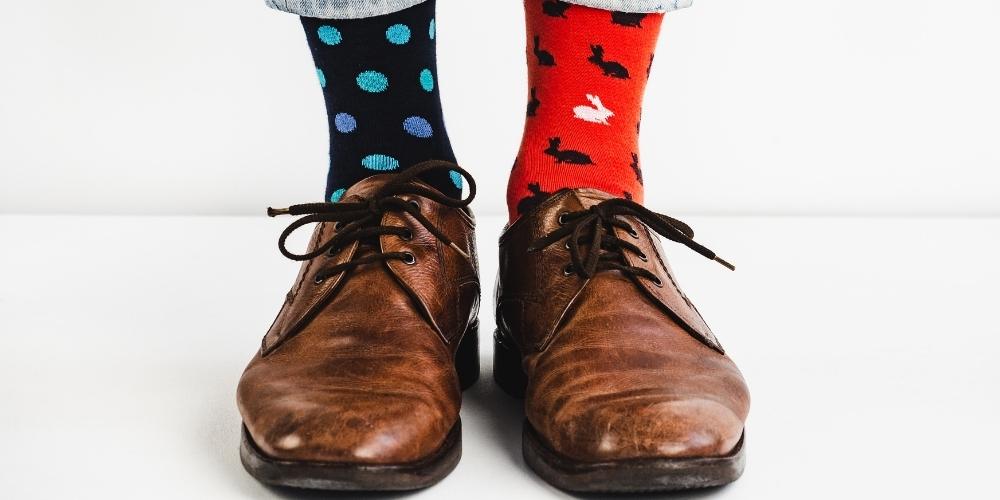
5 Different Sock Materials, & Their Advantages & Disadvantages
Jan 13 , 2021
Tags - Different Sock Materials
As you can imagine, there are different kinds of sock fabrics out there.
And usually, most socks are made of a mixture of different materials.
From a usability perspective, you should choose socks depending on
- the weather
- what you are going to do
- how intense the event is
- how long you are going to wear them
Five Different Sock Materials
1. Cotton
Cotton socks are extremely popular and are often worn during hot/warm weather.
Usually, cotton is soft and comfortable. Hence, cotton socks can be expensive.
In addition, cotton is lightweight, but a strong material. And therefore, when it gets combined with other materials such as polyester or nylon, it includes elasticity and becomes more durable.
Even though they are appropriate for a casual and formal wear, cotton socks are not advised to wear for sporting as it holds moisture and odour, which could form blisters and fungus on your feet.
Cotton is produced all around the world and is commonly categorised as organic cotton, recycled cotton, mercerized cotton, modal cotton, combined cotton and combed cotton. For longer use, it is best to wash cotton socks in cold water.
For sensitive skin, it is best to wear cotton socks (or bamboo) and not synthetic socks.
2. Wool
Wool Socks parallel cotton socks in their popularity. However, wool holds moisture and odour more than cotton.
From a usage perspective, wool has insulating characteristics to keep you warm. Hence, it's worn more regularly during winter/cold weather.
In addition, wool is breathable, water resistant, wrinkle resistant, holds the shape well and comfortable.
From a quality perspective, you can identify the quality of wool by the length and the diameter of the fiber, or atleast by just simply touching it to see if it is comfortable.
If you wear low quality wool socks, it could be uncomfortable, itchy and irritable. Anyways, wool is difficult to clean but it is best not to machine wash wool socks.
Usually, wools can be different from each other depending on, for instance, the sheep breed. Apart from that, there are other different kinds of wool such as Merino wool, goat wool, Alpha wool, Rabbit wool & many more that you can explore.
3. Bamboo
Bamboo socks are a new innovation.
They have many advantages, such as
- Softness
- Sustainability
- Lightness
- Breathability
- Cosiness
- Thermal regulation
- Durability
- Maintaining moisture while keeping the feet fresh, clean and cool.
The only con of Bamboo socks is that they may start to pill sooner than other materials. So, you have to maintain them well.
Due these characteristics, bamboo socks can be worn anytime no matter if it is for casual use or even for sports.
Similarly, as bamboo has anti-microbial characteristics, it is useful for people with skin issues, diabetics and other medical scenarios to use bamboo socks.
In addition, bamboo socks are easily washable, foldable, light and keep the feet fresh while walking long hours. Therefore, they are extremely useful to take while traveling.
4. Synthetics (Nylon, Polyester & Etc)
Synthetics, such as nylon and polyester socks are a relatively new innovation.
They absorb moisture, dry fast and keep the feet fresh. So, these kinds of socks have been recommended to preferably use for day to day activities, compared to cotton, wool, or bamboo.
Also, synthetic socks are stretchy. So, they fit the feet well and sit well.
From a production perspective, synthetics can be mixed with other materials, such cotton or wool to give improved results.
On the negative end, synthetics hold moisture. Therefore, wearing synthetics could lead to fungus growth, and create odour. Due to these conditions, It is not recommended to wear synthetic socks for sensitive skin.
5. Silk
Silk, made from protein fibre in silkworms, is known to be smooth, soft, light weight and moisture absorbing.
In addition, silk socks have insulating characteristics. Hence, they are used in winter and also mixed in synthetic socks.
Although silk has many pros, it can be
- Expensive
- Needs extra care compared to other material socks
- difficult to clean as it is very delicate and tears easily
To learn more, get in touch with us today.
In the meantime, check our range of Casual shoes.